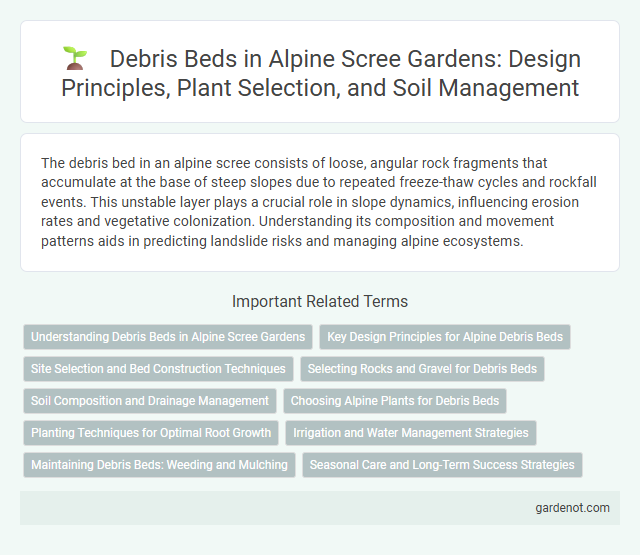The debris bed in an alpine scree consists of loose, angular rock fragments that accumulate at the base of steep slopes due to repeated freeze-thaw cycles and rockfall events. This unstable layer plays a crucial role in slope dynamics, influencing erosion rates and vegetative colonization. Understanding its composition and movement patterns aids in predicting landslide risks and managing alpine ecosystems.
Understanding Debris Beds in Alpine Scree Gardens
Debris beds in alpine scree gardens consist of accumulated rock fragments and organic material that create a unique microhabitat influencing soil stability and moisture retention. These beds support specialized plant species adapted to the harsh, nutrient-poor conditions found in high-altitude environments. Studying the composition and formation of debris beds aids in understanding ecological succession and erosion control within alpine scree ecosystems.
Key Design Principles for Alpine Debris Beds
Alpine debris beds require key design principles focused on stability, permeability, and erosion control to withstand dynamic mountain conditions. Incorporating graded rock sizes ensures effective drainage and load distribution, preventing accumulation-related hazards. Vegetation establishment and structural reinforcements enhance long-term durability against freeze-thaw cycles and slope movements.
Site Selection and Bed Construction Techniques
Selecting a stable site for Alpine scree debris beds requires thorough geological assessment to identify areas with minimal erosion risk and optimal drainage. Bed construction techniques involve layering coarse angular rock fragments to enhance water infiltration while preventing soil loss and promoting vegetation establishment. Employing geotextiles beneath the debris bed can improve structural integrity and reduce sediment migration in steep alpine environments.
Selecting Rocks and Gravel for Debris Beds
Selecting rocks and gravel for alpine scree debris beds requires prioritizing angular, well-graded materials that enhance drainage and stability. Coarse, angular rocks create interlocking structures that resist erosion and support sediment retention. Optimal debris beds incorporate a mix of particle sizes, from gravel to cobbles, ensuring porosity while minimizing fine sediments to prevent compaction.
Soil Composition and Drainage Management
Debris beds in Alpine scree consist primarily of fragmented rock fragments mixed with varying amounts of coarse mineral particles and fine sediments, influencing soil composition significantly. The high permeability of these mixed soils enhances natural drainage, preventing waterlogging and promoting rapid runoff in steep scree slopes. Effective drainage management relies on the soil's granular structure, which aids in minimizing erosion while supporting specialized vegetation adapted to these harsh conditions.
Choosing Alpine Plants for Debris Beds
Selecting alpine plants for debris beds requires prioritizing species adapted to unstable, rocky substrates with excellent drainage and low nutrient availability. Cushion plants like Silene acaulis and Saxifraga oppositifolia thrive in these harsh conditions, stabilizing loose debris while enhancing biodiversity. Root systems that anchor effectively and tolerate frost heaving ensure long-term survival and ecosystem resilience on alpine scree slopes.
Planting Techniques for Optimal Root Growth
Debris beds in alpine scree provide a challenging substrate where careful planting techniques promote optimal root growth and plant stability. Utilizing layered soil amendments and graded particle sizes enhances water retention and aeration, critical for root development in this fast-draining environment. Deep planting with root collars slightly below the debris surface anchors plants securely, reducing exposure to wind erosion and temperature fluctuations.
Irrigation and Water Management Strategies
Debris beds in alpine scree areas play a critical role in natural irrigation by facilitating water retention and slow percolation, which supports vegetation growth and reduces erosion. Effective water management strategies in these regions include constructing micro-catchments and using permeable barriers to optimize water distribution and conserve moisture within the scree debris. These techniques enhance groundwater recharge and stabilize the scree slopes, promoting ecological balance in alpine environments.
Maintaining Debris Beds: Weeding and Mulching
Maintaining debris beds in alpine scree habitats involves regular weeding to prevent invasive species from disrupting native plant growth and ecosystem balance. Applying organic mulch improves soil moisture retention and temperature regulation, promoting healthy seedling development and stabilization of the scree substrate. These practices enhance biodiversity by supporting endemic flora adapted to harsh alpine conditions and reducing erosion risks on unstable slopes.
Seasonal Care and Long-Term Success Strategies
Seasonal care of Alpine scree debris beds involves regular inspection for erosion and sediment buildup during spring thaw and heavy rainfall periods to maintain drainage and stability. Long-term success strategies include planting native drought-resistant vegetation to stabilize loose rock material and implementing geotextile mats to prevent soil displacement. Monitoring moisture levels and adjusting maintenance schedules according to seasonal weather patterns ensures sustained ecological balance and debris bed functionality.
Debris bed Infographic

 gardenot.com
gardenot.com